Sea Watch – Whale Watching off Grand Manan
This is my second post from a recent trip to the fabulous Fundy Isles of New Brunswick. In the first post I went sea kayaking in the fog with Adventure High and found out that it was an exhilarating experience, fog or no fog. Today Alison and I are going out on the water again, but this time we will be joined by many others as we search for whales and other sea life aboard the Day’s Catch with Captain Peter Wilcox. He and his wife Kenda are the owners of Sea Watch Tours which is oldest eco-tourism company in New Brunswick, first starting out in 1969. Their rate of success in spotting whales is so high that the trip is free if no whales are found. With that virtual guarantee I had no problem signing up for the 8:00 AM tour which goes out for four hours. So please join us as we search for some if the fifteen species of whales that have been spotted in the Bay of Fundy.
The first question you might ask is “Why is the Bay of Fundy such a good spot for whale watching?”. As with almost every answer having to do with why certain types of animals congregate in certain areas, the answer is ‘food’. The Bay of Fundy is one of the great natural wonders of the world. Every 24 hours it brings into and drains out of the ever narrowing body of water separating Nova Scotia and New Brunswick the equivalent amount of water that all the rivers in the world pour into the oceans of the world over the same period of time. Think about that. It’s mind boggling. This is what creates not only the highest tides in the world, but also ideal conditions for plankton growth which is the essential bottom line for all ocean life. We’ve all seen the diagrams of a little fish chased by a bigger fish which is chased by a bigger fish etc, just like Russian nesting dolls. Well at the very beginning of this chain is the plankton which are fed on by the tiny shrimplike krill which are fed on by herring and so on up the line. Most of the whales in the Bay of Fundy are of the baleen variety as opposed to toothed whales like orcas and sperm whales. Baleen is a sieve like comb which strains out even creatures as tiny as plankton and krill which is the whale’s main sustenance although a mouthful of herring will not go unappreciated. It is somewhat ironic that the largest creatures who have ever lived on earth subsist on the tiniest food source possible. The fact that they can, tells you just how fecund the Bay of Fundy really is.
OK, with that explanation let’s head off with Sea Watch in search of these behemoths.
Alison and I drive from our lodgings at the Compass Rose Heritage Inn in North Head to Seal Harbour about twenty minutes south of there. It is a pretty little fishing village that at one time was home to a huge number of sardine processing plants that are now abandoned and stand as ghostly reminders of what once was a mighty industry supporting thousands of workers throughout the Fundy Isles.
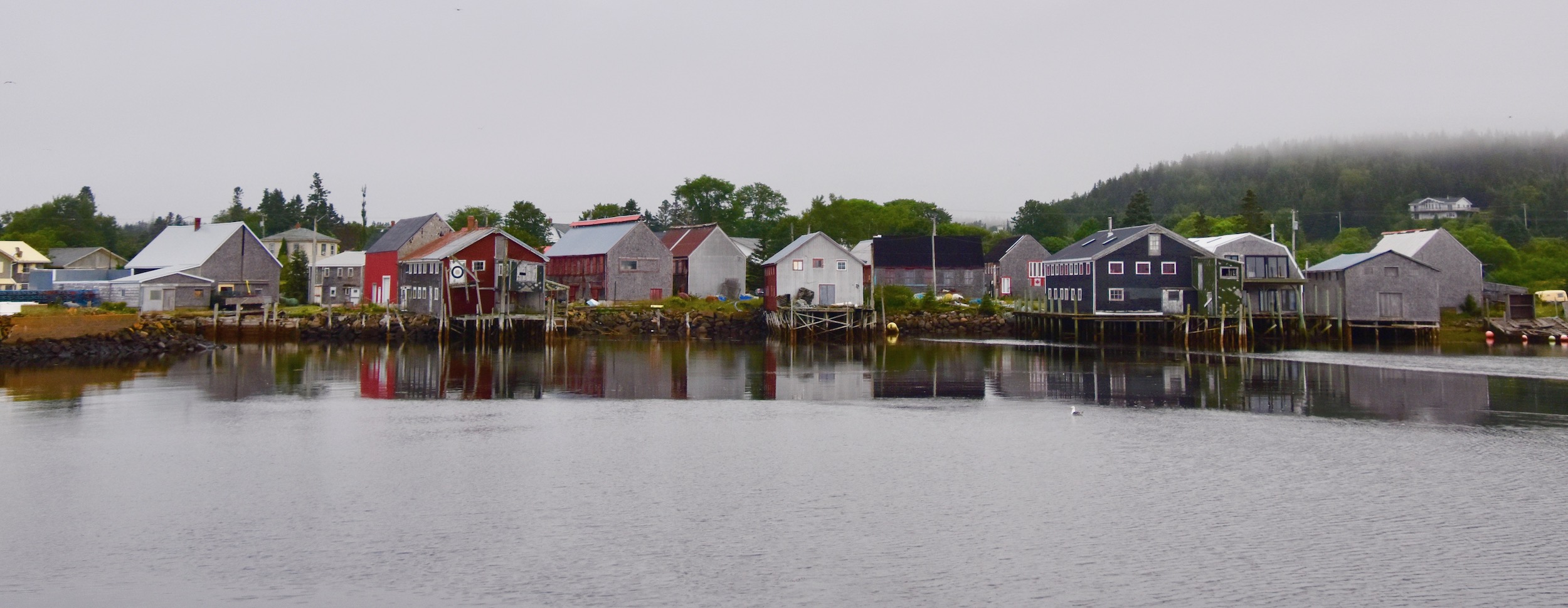
However, Seal Harbour is by no means a dying community. Where sardines were once the backbone of the fishing industry, it is now the even more lucrative lobster fishery that sustains this place. Colourful Cape Islanders are moored in great numbers and provide a nice opportunity for photos before setting out on the Sea Watch tour.
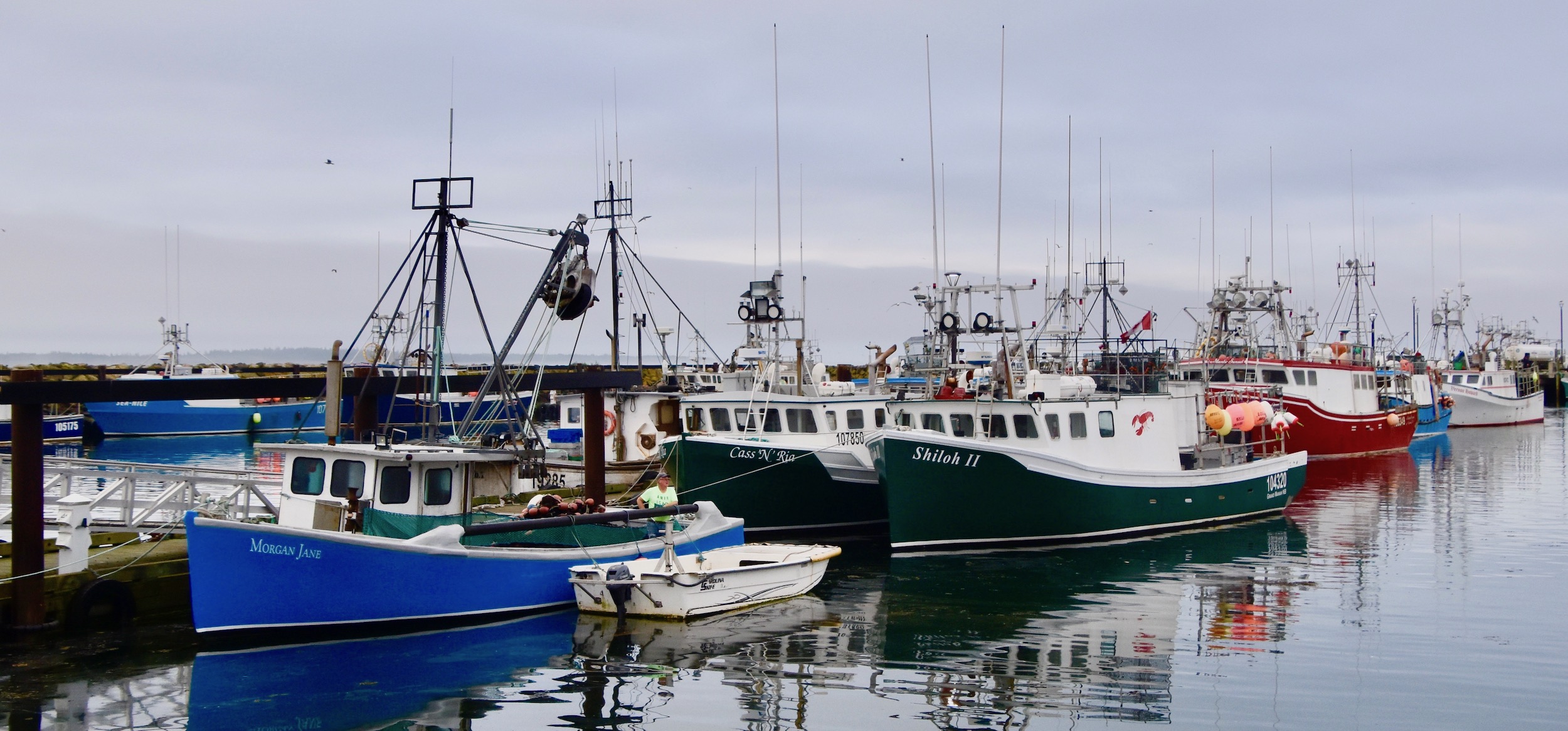
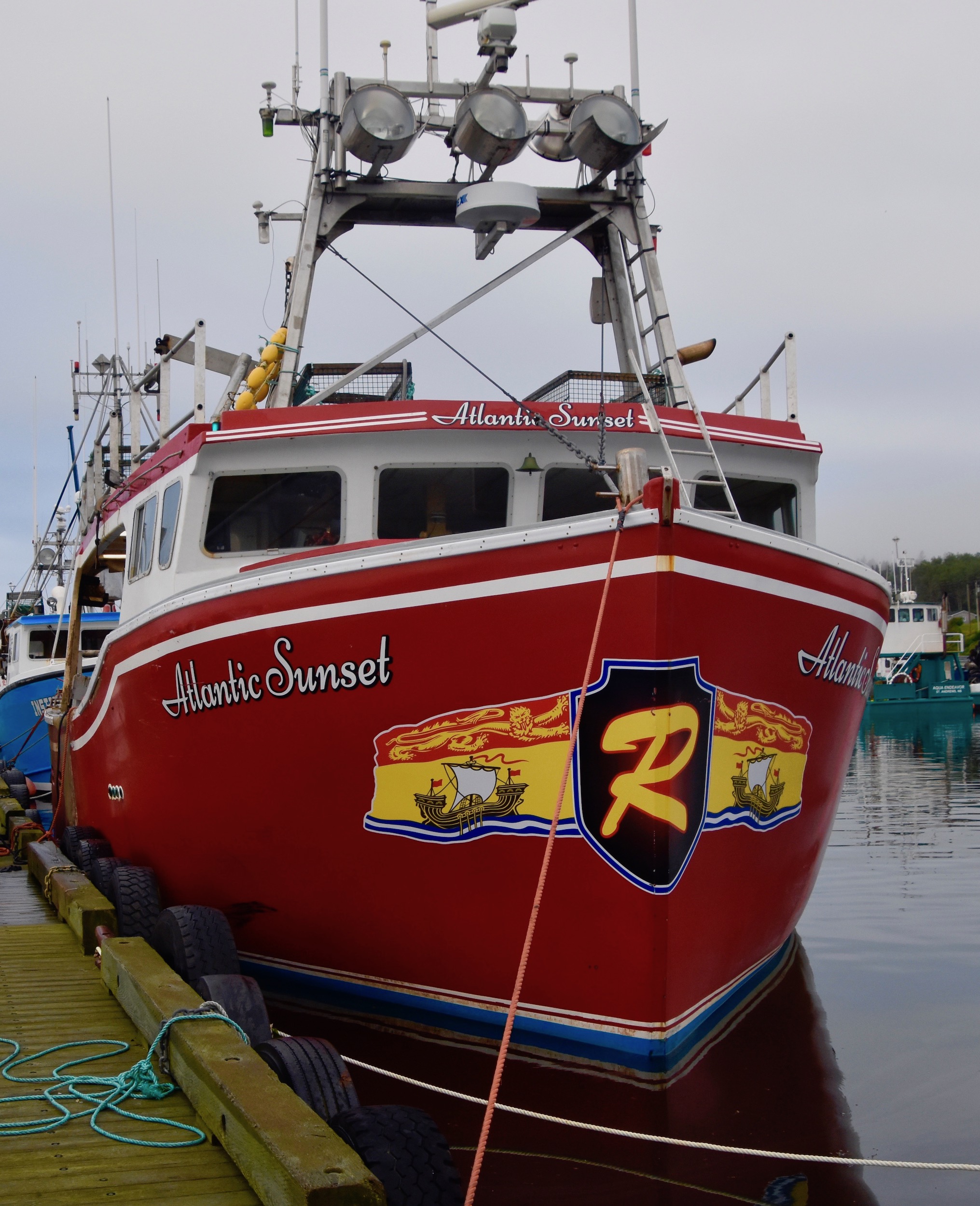
As 8:00 AM approaches we seek out the Day’s Catch where we can see Captain Wilcox, Mate Durlan and a younger guy ready to greet their oncoming guests for the morning’s Sea Watch tour. It’s a good size Cape Islander style boat with rows of seats where ordinarily lobster traps would be kept. All told there are about twenty people on the tour of which at least half are children or teen agers.
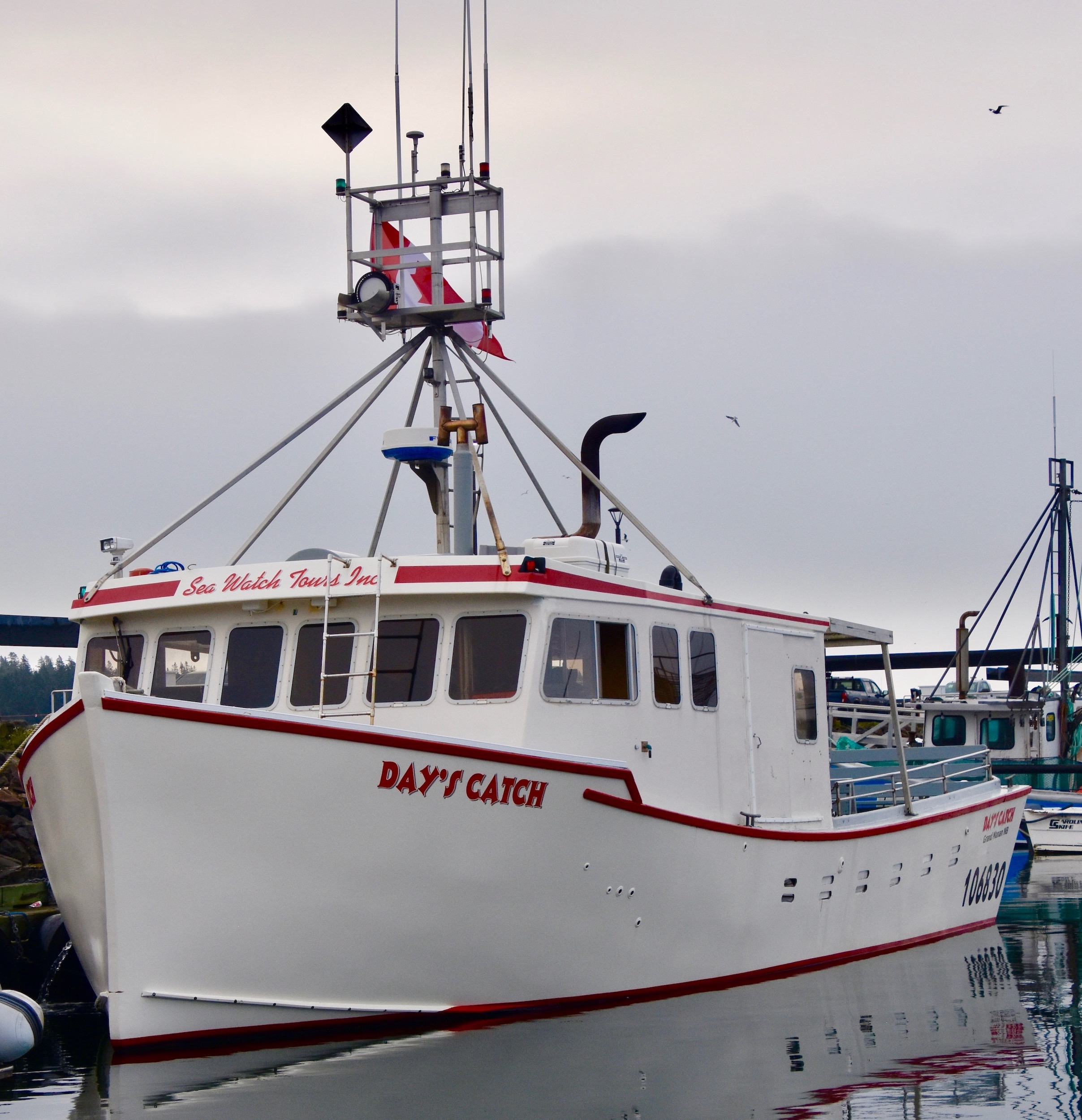
Now a word about preparing for a whale watching cruise on the Bay of Fundy. No matter how bright, sunny and warm it is on land, it is almost certainly going to be much colder on the water. We have gone on these trips from the Nova Scotia side many times and invariably people show up not prepared. Sadly, today is no different with some little girls dressed only in tee shirts and shorts and it’s not bright, sunny and warm. It’s foggy and cool. Here is how Alison dressed for the Sea Watch trip.
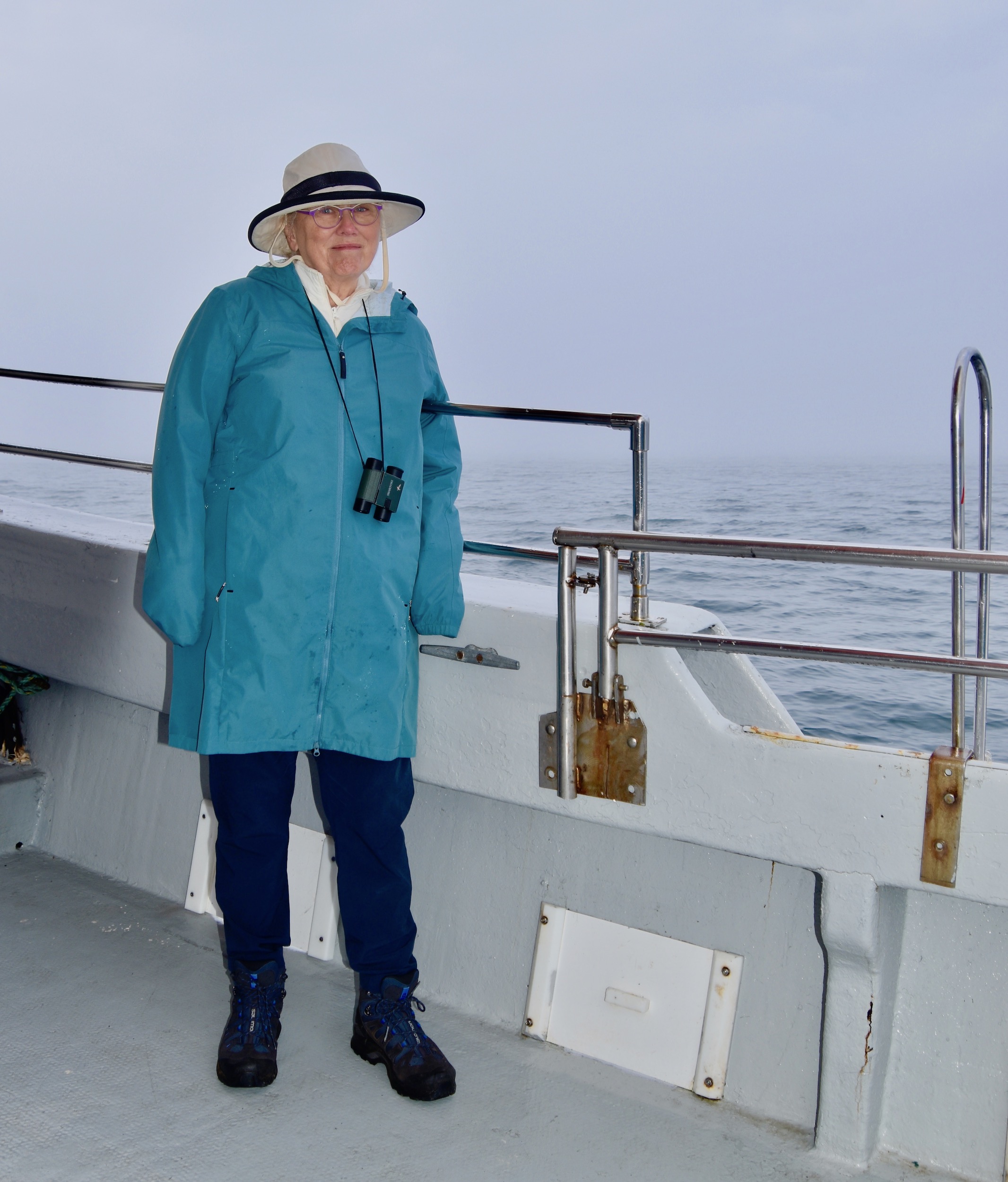
So if you take away anything from this post, let it be to dress appropriately.
Now I mentioned that it was foggy. Not as bad as yesterday, but Captain Wilcox tells us that once we are out on the water it will be much thicker. This means, he says, that we will have to find the whales by listening for them rather sighting them which is obviously the preferred method. He also says that the whales have moved away from White Head where they were the day before and are further out in the bay than usual. This will require an almost ninety minute trip to get to the whaling grounds.
Not long after leaving Seal Harbour we do enter the fog and can see next to nothing. It is moderately rough and some people do get sea sick. There is no sugar coating the fact that this happens to some people and not others. Alison and I are lucky that we do not have this affliction which is caused by problems in the inner ear affected by the rocking motion of the boat.
One feature that the Sea Watch tour provides is a large screen which shows the boat’s position and heading as well as the various shoals, islands and submerged rocks that made this area treacherous for mariners before the invention of modern navigation instruments. Given today’s conditions, I cannot imagine what it must have been like for sailors years ago when you could hear the crashing of waves against dangerous shoals, but not be able to see where the danger lie. Terror and prayer must have been omnipresent.
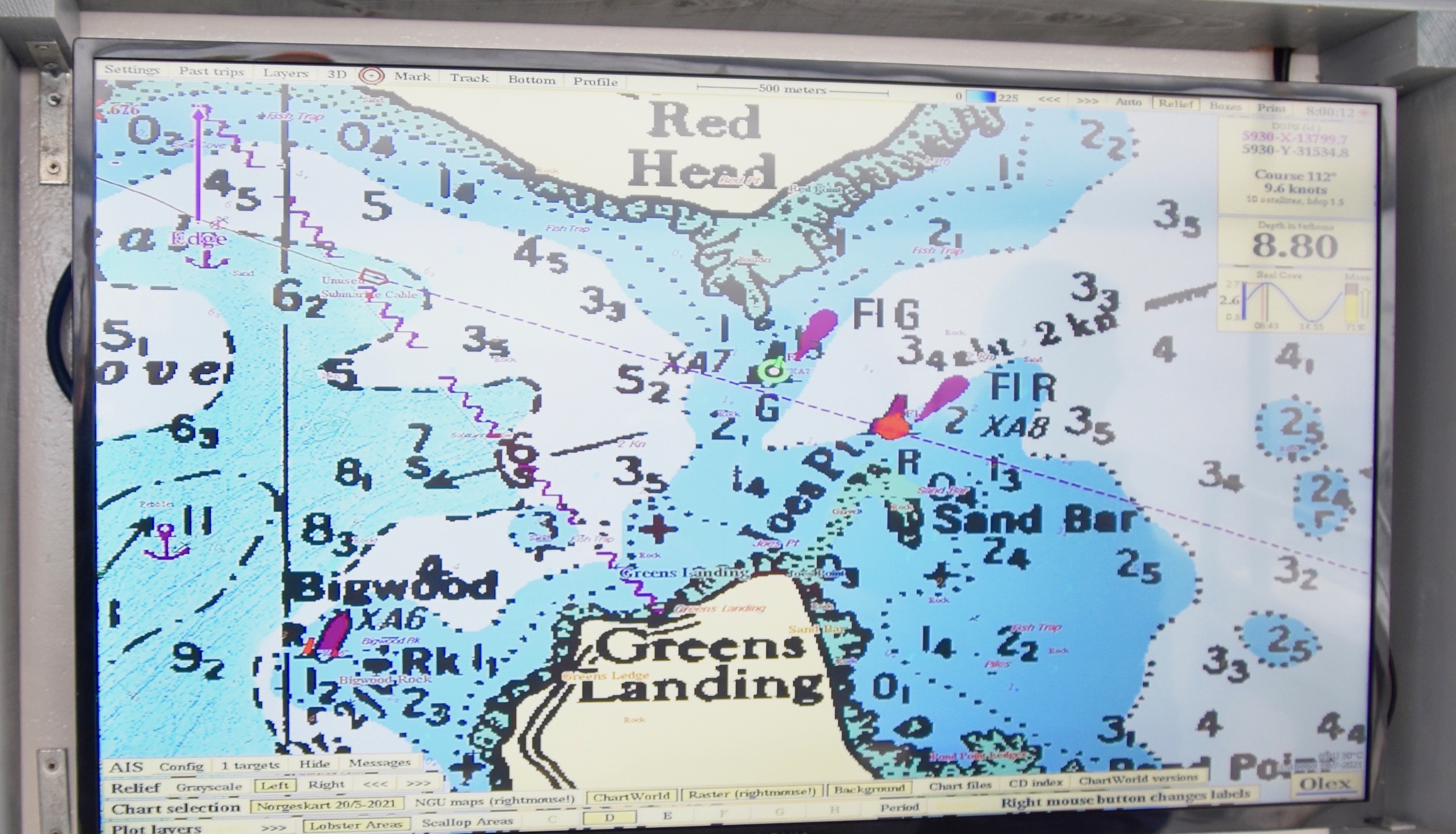
Sorry for sounding a bit like a downer talking about sea sickness and hidden navigation menaces, because other than for those who are sea sick, the mood is actually quite jovial. And just because it’s quite foggy, doesn’t mean there is nothing to see. I am a birder and enjoy these excursions as much for the birds as the sea life. The Bay of Fundy has a large number of bird species that are known as pelagic, which means that except for breeding, they simply never come ashore. That in turn means you can only spot them from a boat or visit their breeding grounds. Sea Watch does have a tour to Machias Seal Island which has a large puffin and razorbill colony. As far as I am aware they are the only company that has a permit to land people on shore during the nesting season. Guests must remain in a blind while on the island, but Captain Wilcox tells me the puffins are literally only a few feet away. This is definitely something I’m putting on my bucket list for next year.
Grand Manan was so well known for its various marine birds that John James Audubon visited in 1833 specifically to find puffins and herring gulls. Now you might think that herring gulls, which are ubiquitous today, could be seen anywhere, but back then their eggs where greatly prized and they were actually endangered. His painting of the herring gull was done on White Head island, just off Grand Manan.
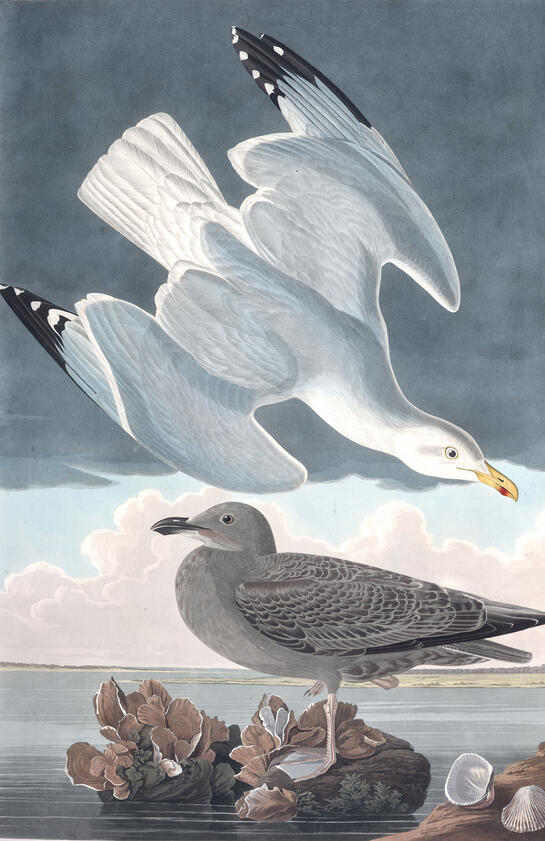
But for today, we are limited to what we can see from the boat and the list of pelagics on this Sea Watch tour is surprisingly long – razorbill auks, thick-billed and common murres, leach’s petrel and greater shearwaters, the latter of which come right up to the boat. Other possibilities include puffins, jaegers, skuas, fulmars and sooty shearwaters.
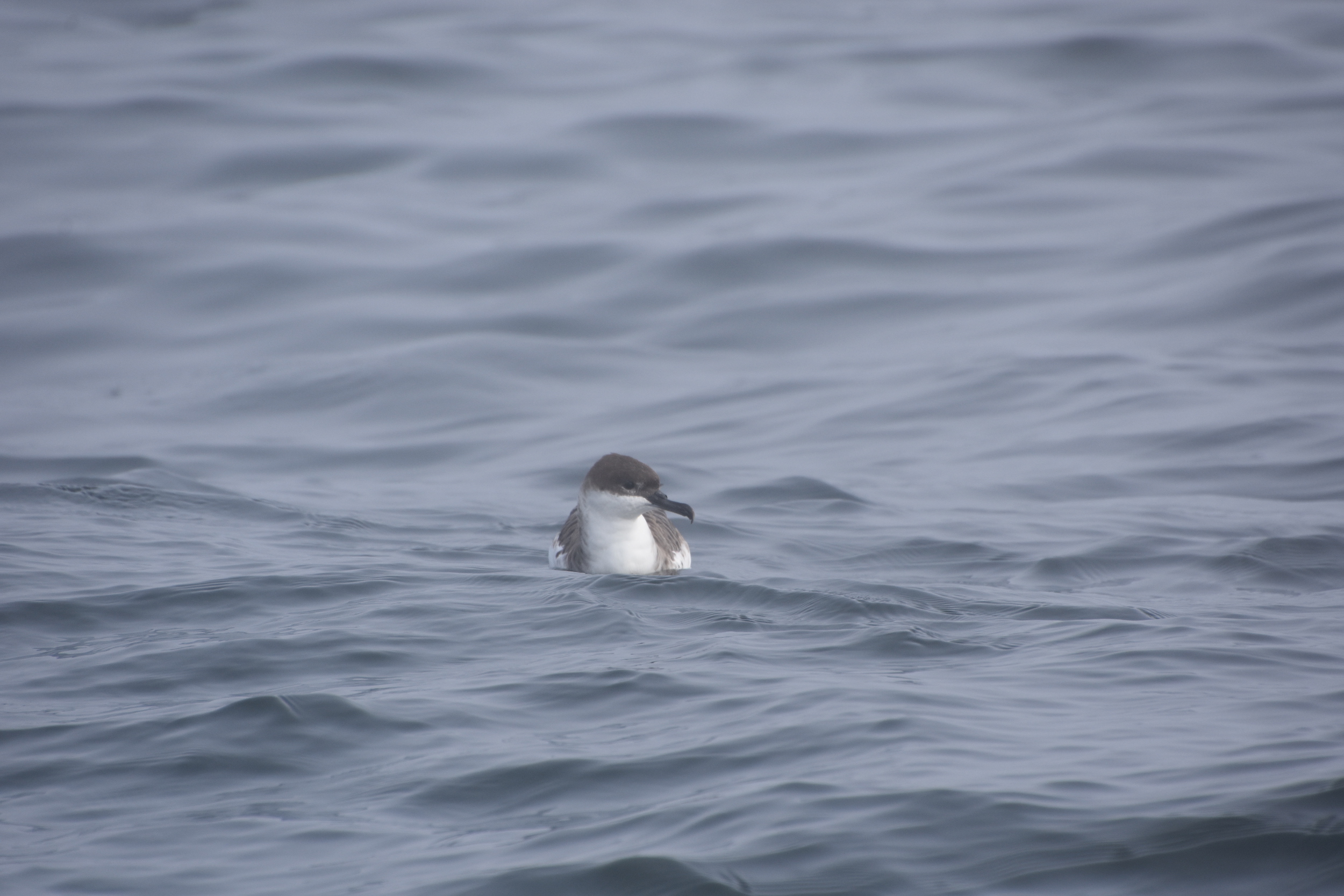
Now here is where I tell my big fish that got away story. Far off in the distance I saw the dim outline of something very large and very white – way bigger than a herring gull or black-backed gull or a skua, all of which are pretty big. Due to the fog I couldn’t get a good look, but a few minutes later a huge bird flew by the boat and I would swear to God it was an albatross. I’ve seen albatrosses in Hawaii so I know their general size, shape and wing span. I asked Mate Durlan who is an avid and experienced birder about the possibility of it being a yellow-nosed albatross and he looked at me like I was nuts. However, when after talking he learned that I generally know my birds he was more receptive. He had never seen one in his thirty plus years of birding on the Bay of Fundy, but they are seen on very rare occasions, always in summer. So who knows? Maybe I saw something far rarer than a whale.
Other visitors to the boat include gray seals who were a wonder to many of the people aboard. I’m used to seeing them, but for the uninitiated they are definitely a great thing to see, particularly when they engage you in a staring contests like this gal.
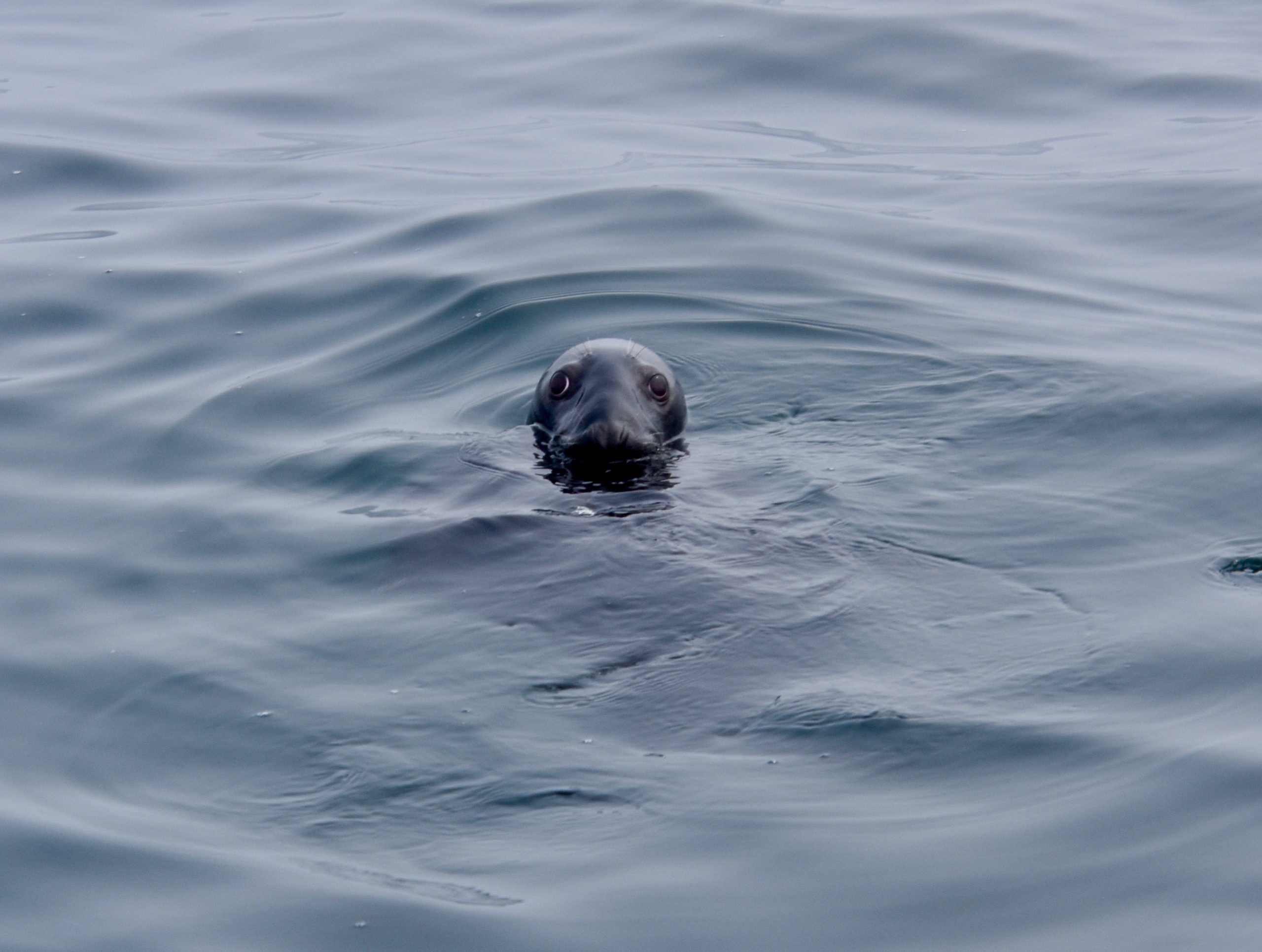
By now you are wondering – what about the whales? Well the bottom line is we didn’t see one, but to my mind we saw something better which I’ll get to. When we did reach a spot that was teeming with seabirds and seals there should have been whales. However, to find them Captain Wilcox needed to find a relatively calm spot, which he did, turn off the engine, which he did and then listen quietly for the sound of a whale’s exhaling spout, which we didn’t. Some of the little kids on the boat were just too fidgety and talkative to be quiet. Maybe there were whales around, maybe not. We’ll never know.
What we did see was one of the largest and most active pods of dolphins I have ever seen. These were the very large white-sided dolphins which unlike their more common brethren harbour porpoises, do not fear the noise made by the boat. They surrounded the boat and began following us, leaping clear out of the water a few times. One group of three did what looked like a coordinated triple jump that was spectacular. It was so sudden and quick I couldn’t get it on camera, but I did get this picture which shows how close to the boat they came. For me this was a highlight maybe not as good as a breaching humpback, but every bit as good or better than a minke or fin whale, two of the other species frequently seen on Sea Watch tours.
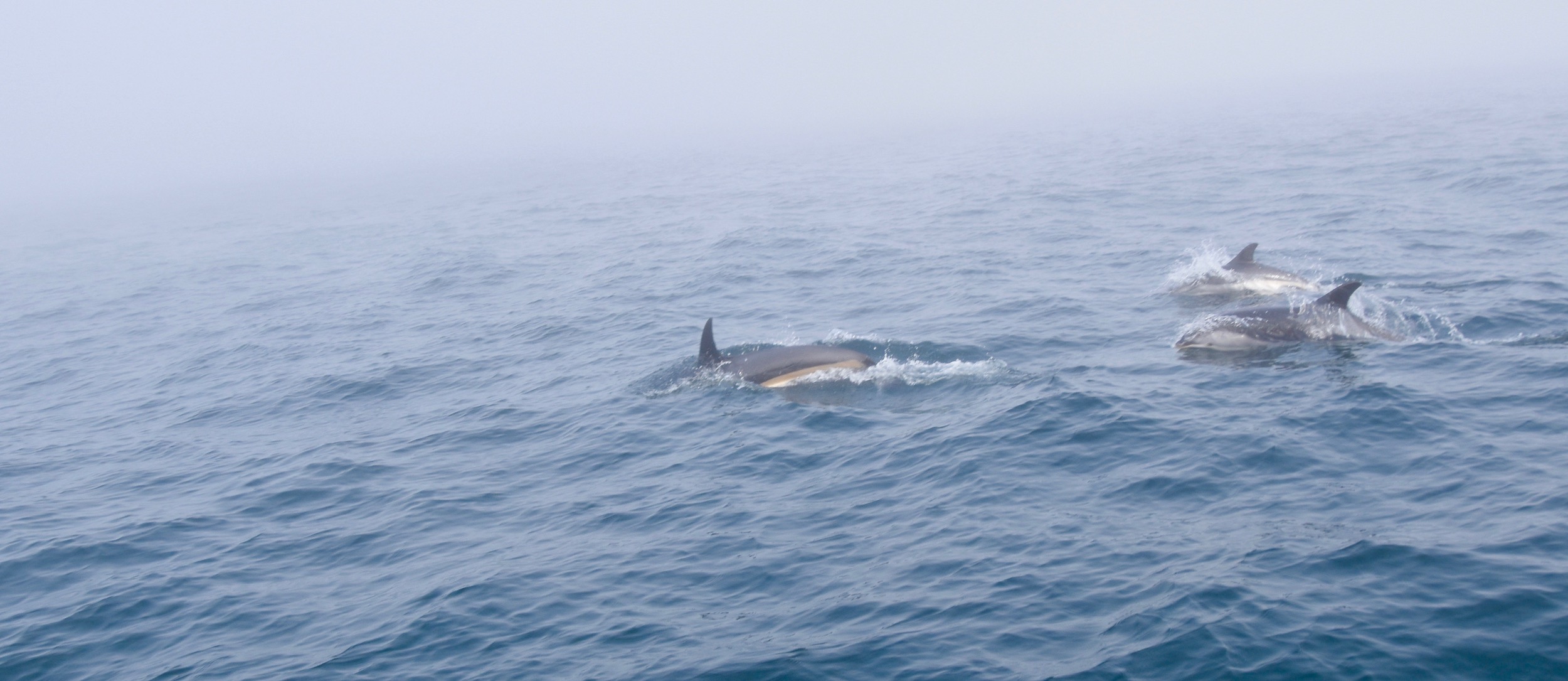
So the guy who brought rain to Death Valley and snow to Mississippi managed to get the Sea Watch tour skunked for the first time since 2019, a stretch of over 100 tours. To his credit Captain Wilcox, who didn’t seem the least perturbed at losing a substantial amount of money, didn’t try to pawn off the dolphins as whales, because technically they are cetaceans which include all whale species. If he had advertised the tour as a dolphin and seal watching excursion I doubt that anyone would have felt they hadn’t got their money’s worth. The old saying about the worst day of fishing being better than the best day at the office applies here. The worst day of whale watching is better than never having set sail at all, unless of course you’re one of those who got sea sick.
This is Peter Wilcox’ last year running the Sea Watch tours. However, he has sold the company to someone who will continue to run it as he has for over fifty years. Happy retirement Peter!

